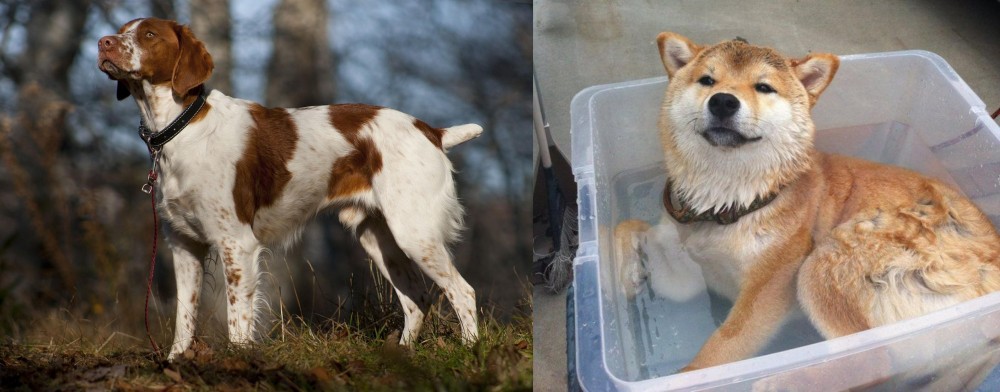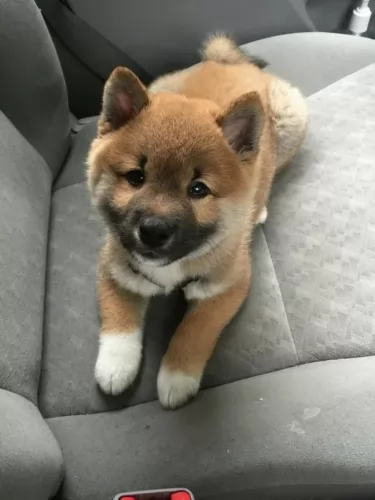 Petzlover
Petzlover Brittany is originated from France but Shiba Inu is originated from Japan. Brittany may grow 9 cm / 4 inches higher than Shiba Inu. Brittany may weigh 9 kg / 20 pounds more than Shiba Inu. Both Brittany and Shiba Inu has almost same life span. Brittany may have more litter size than Shiba Inu. Both Brittany and Shiba Inu requires Low Maintenance.
Brittany is originated from France but Shiba Inu is originated from Japan. Brittany may grow 9 cm / 4 inches higher than Shiba Inu. Brittany may weigh 9 kg / 20 pounds more than Shiba Inu. Both Brittany and Shiba Inu has almost same life span. Brittany may have more litter size than Shiba Inu. Both Brittany and Shiba Inu requires Low Maintenance.
 One of the most intense bird dog breeds in existence is the Brittany, bred for hunt. The breed used to be called the Brittany Spaniel, but since the breed is closer to a setter or pointer, that moniker has been dropped. The Brittany is named for the French Province in which they were originally developed. Sometime from the 17th to the 19th centuries, the breed was developed. Images of a very similar dog can be found on 17th century paintings and tapestries. However, the first written description comes from 1850 by a Reverend Davies, describing a hunting episode. The breed was recognized officially in the early part of the 20th century and made a splash at the 1900 Paris Dog Show.
One of the most intense bird dog breeds in existence is the Brittany, bred for hunt. The breed used to be called the Brittany Spaniel, but since the breed is closer to a setter or pointer, that moniker has been dropped. The Brittany is named for the French Province in which they were originally developed. Sometime from the 17th to the 19th centuries, the breed was developed. Images of a very similar dog can be found on 17th century paintings and tapestries. However, the first written description comes from 1850 by a Reverend Davies, describing a hunting episode. The breed was recognized officially in the early part of the 20th century and made a splash at the 1900 Paris Dog Show.
The first official standards were written in about 1907 and the breed was recognized by the American Kennel Club (AKC) in 1934.The Brittany is expected to point to and then retrieve birds and other small ground game. Because the Brittany both points and retrieves they are known in the U.K. as a Hunt, Point and Retrieve breed or an HPR, and they have more Dual Champions than the rest of the AKC Sporting group.
There are actually two types of Brittanys in the minds of many breeders. There is the “French” Brittany and the “American” Brittany. When the breed arrived in the United States in 1931 they became immensely popular in a short period of time. In 1942 American Breeders began the American Brittany Club, rewriting the French standard to fit the dog they knew. Today there are definitely difference between the two sub-sets that can easily be seen. The French dog is smaller than the American dog. The American dog is a runner pacing ahead of the hunter while the French dog works more closely with their human companions. Another visible difference is that the French accept black spotted Brittanys, while in the United States a black spotted coat is considered a fault. Both sub-sets are known for their willingness to follow human directions, their eagerness for the hunt, and their agility and speed.
Unfortunately, the European wars took their toll on this breed as they did on many others. Following the second World War, their numbers in Europe were drastically reduced. The French had stop breeding them altogether during the war. It was in this depleted gene pool that the French agreed to accept the black spotted Brittany. Along with the U.S., Canada also does not recognize the black spotted Brittany.
 The Shiba Inu hails from Japan and was a dog bred to hunt birds and small game. The dog is one of 6 native breeds in Japan. Today he is essentially a companion dog in both Japan and the United States.
The Shiba Inu hails from Japan and was a dog bred to hunt birds and small game. The dog is one of 6 native breeds in Japan. Today he is essentially a companion dog in both Japan and the United States.
He is actually one of the smaller spitz dogs in the country but known for his boldness.
The first Shiba Inu was imported into the United States in 1954 and was recognized by their Kennel Club in the Miscellaneous Class and also the Non-Sporting Group.
 The Brittany is much like other hunting dogs – pointers and retrievers – in size and stature. He is solid and strong but not heavy. He is compact with an average size head and floppy ears, docked tails or short natural tails, and expressively intelligent looking eyes. He is athletic, energetic, and alert. He has a long, elastic and free gait. The French dog is smaller and the dog with black spots is accepted. The American Brittany is larger and only a tri-color of orange, liver and white is acceptable.
The Brittany is much like other hunting dogs – pointers and retrievers – in size and stature. He is solid and strong but not heavy. He is compact with an average size head and floppy ears, docked tails or short natural tails, and expressively intelligent looking eyes. He is athletic, energetic, and alert. He has a long, elastic and free gait. The French dog is smaller and the dog with black spots is accepted. The American Brittany is larger and only a tri-color of orange, liver and white is acceptable.
 The Shiba Inu is a medium sized, athletic dog standing at between 33cm and 43cm in height both male and female and weighing in the region of 6 to 11kg.
The Shiba Inu is a medium sized, athletic dog standing at between 33cm and 43cm in height both male and female and weighing in the region of 6 to 11kg.
He is an agile dog, known for his feline agility. He has the typical spitz dog erect ears and slanted eyes with the tail curling over the back.
The coat is available in a number of colors – cream, red, sesame, black and tan.The double coat is thick and is made up of straight, stiff kind of hair.
This is an intelligent, independent, alert, strong willed dog who has a calm aura about him. He is stubborn too, so it will be best to have him trained or socialized just to make him more amicable to get along with.
As he is a dog that just loves his human family, this training helps him to get along with other dogs too. He is possessive with his human family, wanting to guard them and everything he regards as his territory.
 The Brittany is particularly trainable and friendly. They love to play and are sweet-natured. They don’t due well with harsh correction though and a stern look will cause them to wither. Socialize them young or they can become shy around strangers. They are loyal and family oriented. They can easily become attached to their humans.
The Brittany is particularly trainable and friendly. They love to play and are sweet-natured. They don’t due well with harsh correction though and a stern look will cause them to wither. Socialize them young or they can become shy around strangers. They are loyal and family oriented. They can easily become attached to their humans.
 He is the smallest of several spitz dogs that originated in Japan. He is known for his bold, feisty personality and for being so good natured as well. Other excellent characteristics are intelligence, strong-willed, loyal and loving and he has a calm, confident dignity around him.
He is the smallest of several spitz dogs that originated in Japan. He is known for his bold, feisty personality and for being so good natured as well. Other excellent characteristics are intelligence, strong-willed, loyal and loving and he has a calm, confident dignity around him.
He will get on well with kids and other dogs he has grown up with but he can be a bit aggressive towards dogs he doesn’t know.
Always ensure good exercise. Getting outside and active is important for this dog.
You can certainly benefit from having this wonderful dog in your life as he has some excellent characteristics.
 The breed is a hardy one and Brittanys are mostly healthy dogs. In Europe 1 in 5 dogs dies of old age and that age is usually 14 or 15 years. They do have a few issues that they may be susceptible to. These would include:
The breed is a hardy one and Brittanys are mostly healthy dogs. In Europe 1 in 5 dogs dies of old age and that age is usually 14 or 15 years. They do have a few issues that they may be susceptible to. These would include:
 Shiba Inus are generally healthy, but like all breeds, they're prone to certain health conditions. Look out for things such as hip dysplasia, hypothyroidism, bloat, cancer, eye diseases and skin allergies.
Shiba Inus are generally healthy, but like all breeds, they're prone to certain health conditions. Look out for things such as hip dysplasia, hypothyroidism, bloat, cancer, eye diseases and skin allergies.
Skin allergies can come about because of being allergic to food, fleas, too much shampooing and some medications. It can be traumatic for your pet who will sometimes chew and bite to get relief. Treatment varies but get your pet to the vet.
There is pressure in the eye, and symptoms can include vision loss and pain. Glaucoma can be treated with eye drops but sometimes surgery is required.
 Don’t overfeed your Brittany. Keep him at hunting weight by feeding a half a cup up to 2 cups per day depending on the size of your dog and activity levels. Serve this in two meals not one.
Don’t overfeed your Brittany. Keep him at hunting weight by feeding a half a cup up to 2 cups per day depending on the size of your dog and activity levels. Serve this in two meals not one.
Ears – prone to infections – make sure that you check them and wipe them out routinely to prevent infections.
Hip Dysplasia – bones don’t fit well into joints – this can be genetic or otherwise, causing lameness and arthritis. If severe it can require surgery to correct.
Epilepsy – mild or serious seizures are possible. This can be genetic/hereditary but is set off by an infectious disease of the brain, head injury, poison, tumor, or metabolic disorder. There is no cure, but medication can be very effective.
Hypothyroidism – Low levels of thyroid hormone – can cause drooping eyelids, obesity, lethargy, mental difficulties or irregular heat cycles or all of this. Medication is available as it is for humans but must be taken daily for the rest of the dog’s life
Canine Discoid Lupus Erythematosus – autoimmune disease that is rare in dogs. Cats and humans can also have it. It is a skin disease and does not become the more serious and deadly Systemic Lupus. The Discoid version of this disease causes loss of pigmentation and a scaling on the nose which can then progress to the skin around the ears, eyes and genitals. There could be ulcerated lesions and tissue death in more severe cases. Sun exposure can make the condition worse.
The Brittany is a hunting dog that acts like a pointer but will retrieve fowl and birds in the water or on land. If you don’t hunt, the Brittany can still be your family dog. They need lots of exercise and mental stimulation. They need a job if they are not going to hunt and expect them to be distracted by every bird they see. Try flyball, agility, FAST CAT, field trials and dock diving. They are very task oriented and have boundless energy. They excel at obedience and confirmation as well.
 A nice long walk out and about in the neighborhood is good for this dog. Apart from a daily workout, he will love to come running with you or if you go cycling, he will run next to you. He will require exercise every day.
A nice long walk out and about in the neighborhood is good for this dog. Apart from a daily workout, he will love to come running with you or if you go cycling, he will run next to you. He will require exercise every day.
Brushing your Shiba Inu will be required at least twice a week as he is a dog that sheds quite a bit throughout the year. You want to get rid of those loose hairs to keep him looking nice and groomed.
Never pop sugary treats into your pets mouth and avoid feeding him spicy, toxic foods. It can drastically upset his digestion.
You can feed your Shiba Inu commercially manufactured food but it should be the best quality ones. Give him some tasty homemade food too. Simply add into one big pot chicken, brown rice or pasta and spinach, sweet potatoes and carrots. This food can all be chopped up, refrigerated and added warmed up and in small portions to your pets dry kibble once or twice a week.
Try and also give him some raw meat occasionally. Ensure that there is always a bowl of fresh, cool water within his reach.